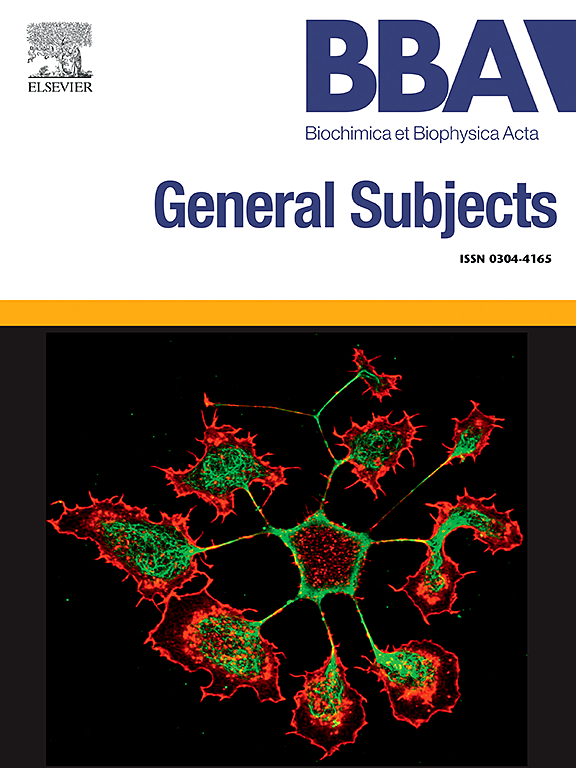FAHFA promotes intracellular calcium signaling via activating the fat taste receptor, CD36 and Src protein kinases in mice taste bud cells
IF 2.8
3区 生物学
Q3 BIOCHEMISTRY & MOLECULAR BIOLOGY
Biochimica et biophysica acta. General subjects
Pub Date : 2024-10-18
DOI:10.1016/j.bbagen.2024.130722
引用次数: 0
Abstract
Two lipid sensors, CD36 and GPR120, are crucial for the orosensory detection of fat taste and for mediating fat preference. However, the mechanism by which endogenous lipid (FAHFA) binds to CD36 to initiate intracellular signaling remains unexplained. Hence, the primary objective of this study is to investigate the binding mechanism of FAHFA to CD36 and its role in isolated mouse taste bud cells (mTBCs). The Schrodinger platform was used to assess the molecular dynamics of protein and ligand interactions, and an in vitro experiment was used to validate the findings. Based on the docking score of the ligand, the molecular mechanistic activities of the targeted complexes, CD36–5-POHSA (−8.2 kcal/mol), were investigated using the dynamic simulation. In comparison to linoleic acid (LA), POHSA rapidly increased [Ca2+]i via acting on CD36, and 5-POHSA treatment in mTBCs activated src-kinase at 20 μM. CD36 siRNA transfection in TBCs downregulate the CD36 protein expression as well as [Ca2+]i flux. This study suggests that 5-POHSA may help combat taste abnormalities and the adverse effects of obesity by binding to the lingual CD36 receptor and activating the tongue-brain axis.
FAHFA 通过激活小鼠味蕾细胞中的脂肪味觉受体、CD36 和 Src 蛋白激酶促进细胞内钙信号转导。
CD36和GPR120这两个脂质传感器对于脂肪味道的口感检测和脂肪偏好的介导至关重要。然而,内源性脂质(FAHFA)与 CD36 结合以启动细胞内信号传导的机制仍未解释。因此,本研究的主要目的是探讨 FAHFA 与 CD36 的结合机制及其在离体小鼠味蕾细胞(mTBCs)中的作用。本研究利用薛定谔平台评估了蛋白质和配体相互作用的分子动力学,并利用体外实验验证了研究结果。根据配体的对接得分,利用动态模拟研究了目标复合物 CD36-5-POHSA(-8.2 kcal/mol)的分子机理活性。与亚油酸(LA)相比,POHSA 可通过作用于 CD36 快速增加[Ca2+]i,5-POHSA 在 20 μM 时可激活 mTBC 中的 src 激酶。转染 CD36 siRNA 的 TBCs 可下调 CD36 蛋白表达和[Ca2+]i 通量。这项研究表明,5-POHSA 可通过与舌 CD36 受体结合并激活舌脑轴,帮助对抗味觉异常和肥胖的不良影响。
本文章由计算机程序翻译,如有差异,请以英文原文为准。
求助全文
约1分钟内获得全文
求助全文
来源期刊

Biochimica et biophysica acta. General subjects
生物-生化与分子生物学
CiteScore
6.40
自引率
0.00%
发文量
139
审稿时长
30 days
期刊介绍:
BBA General Subjects accepts for submission either original, hypothesis-driven studies or reviews covering subjects in biochemistry and biophysics that are considered to have general interest for a wide audience. Manuscripts with interdisciplinary approaches are especially encouraged.
 求助内容:
求助内容: 应助结果提醒方式:
应助结果提醒方式:


